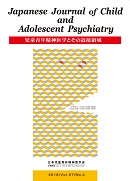Volume 58, Issue 4
Displaying 1-21 of 21 articles from this issue
- |<
- <
- 1
- >
- >|
The 57th Congress of The Society for Child and Adolescent Psychiatry at Okayama Convention Center
Perspective of Child and Adolescent Psychiatry
Memorial Lecture
-
2017Volume 58Issue 4 Pages 435-442
Published: August 01, 2017
Released on J-STAGE: August 21, 2019
Download PDF (773K)
Memorial Lecture
-
2017Volume 58Issue 4 Pages 443-450
Published: August 01, 2017
Released on J-STAGE: August 21, 2019
Download PDF (1211K) -
2017Volume 58Issue 4 Pages 451-453
Published: August 01, 2017
Released on J-STAGE: August 21, 2019
Download PDF (604K)
Education Session
-
2017Volume 58Issue 4 Pages 454-458
Published: August 01, 2017
Released on J-STAGE: August 21, 2019
Download PDF (680K) -
2017Volume 58Issue 4 Pages 459-467
Published: August 01, 2017
Released on J-STAGE: August 21, 2019
Download PDF (706K)
Educational Lecture
-
2017Volume 58Issue 4 Pages 468-469
Published: August 01, 2017
Released on J-STAGE: August 21, 2019
Download PDF (561K) -
2017Volume 58Issue 4 Pages 470-476
Published: August 01, 2017
Released on J-STAGE: August 21, 2019
Download PDF (790K) -
2017Volume 58Issue 4 Pages 477-501
Published: August 01, 2017
Released on J-STAGE: August 21, 2019
Download PDF (1180K) -
2017Volume 58Issue 4 Pages 502-506
Published: August 01, 2017
Released on J-STAGE: August 21, 2019
Download PDF (712K) -
2017Volume 58Issue 4 Pages 507-513
Published: August 01, 2017
Released on J-STAGE: August 21, 2019
Download PDF (733K) -
2017Volume 58Issue 4 Pages 514-520
Published: August 01, 2017
Released on J-STAGE: August 21, 2019
Download PDF (719K) -
2017Volume 58Issue 4 Pages 521-531
Published: August 01, 2017
Released on J-STAGE: August 21, 2019
Download PDF (1210K) -
2017Volume 58Issue 4 Pages 532-536
Published: August 01, 2017
Released on J-STAGE: August 21, 2019
Download PDF (699K) -
2017Volume 58Issue 4 Pages 537-543
Published: August 01, 2017
Released on J-STAGE: August 21, 2019
Download PDF (814K) -
2017Volume 58Issue 4 Pages 544-549
Published: August 01, 2017
Released on J-STAGE: August 21, 2019
Download PDF (749K) -
2017Volume 58Issue 4 Pages 550-555
Published: August 01, 2017
Released on J-STAGE: August 21, 2019
Download PDF (914K) -
2017Volume 58Issue 4 Pages 556-560
Published: August 01, 2017
Released on J-STAGE: August 21, 2019
Download PDF (743K)
Introduction
-
2017Volume 58Issue 4 Pages 561-566
Published: August 01, 2017
Released on J-STAGE: August 21, 2019
Download PDF (722K)
Research Data
-
2017Volume 58Issue 4 Pages 567-581
Published: August 01, 2017
Released on J-STAGE: August 21, 2019
Download PDF (981K)
Report of the 57th Congress of the Society for Child and Adolescent Psychiatry
-
2017Volume 58Issue 4 Pages 582-586
Published: August 01, 2017
Released on J-STAGE: August 21, 2019
Download PDF (796K)
Book Review
-
2017Volume 58Issue 4 Pages 587-588
Published: August 01, 2017
Released on J-STAGE: August 21, 2019
Download PDF (574K)
- |<
- <
- 1
- >
- >|
